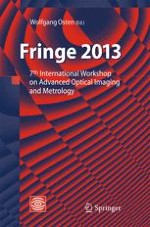2014 | OriginalPaper | Buchkapitel
Measurement of Aspheres and Free-Form Surfaces with the Tilted-Wave-Interferometer
verfasst von : Goran Bastian Baer, Johannes Schindler, Christof Pruss, Wolfgang Osten
Erschienen in: Fringe 2013
Verlag: Springer Berlin Heidelberg
Aktivieren Sie unsere intelligente Suche, um passende Fachinhalte oder Patente zu finden.
Wählen Sie Textabschnitte aus um mit Künstlicher Intelligenz passenden Patente zu finden. powered by
Markieren Sie Textabschnitte, um KI-gestützt weitere passende Inhalte zu finden. powered by
In the area of high performance optics aspherical surfaces have become the solution of choice over the past years [1] [2]. The advantage of aspherical, compared to spherical elements, is the highly increased degree of freedom for the optics design. This allows better correction of aberrations, by simultaneously reducing the number of elements needed to fulfill a given design target, enabling the construction of more compact optical systems, with higher optical performance at the same time. As a result of these convincing advantages aspherical optics are widely used in state of the art optical systems, starting from mass products like imaging systems for micro cameras in smartphones, reaching to high end optical systems used in lithography or space applications. Even more degrees of freedom in the design can be reached, if the rotational symmetry of the aspheric surface is broken. Such free-form surfaces that do not have to show any symmetry at all can be used to further improve the performance of an optical system. One possibility is the construction of systems where the elements are no longer arranged along a straight line, but where the optical axis is folded. By taking advantage of this design option it is possible to develop very compact systems, which also are less sensitive to mechanical and thermal influences. Another advantage of off-axis systems that can be realized with free-form elements is the avoidance of reflexes that often occur at the center of the lens in a classical system. This is especially important for applications with coherent sources. Further, certain wavelengths demand the usage of mirror optics instead of lenses, if there aren’t any optical refractive materials with tolerable absorption available. To avoid central obscurations, here again the easiest way is to use free-from mirrors. One example for this kind of optical systems is the EUV lithography that will be used in the next generation of semiconductor fabrication.
